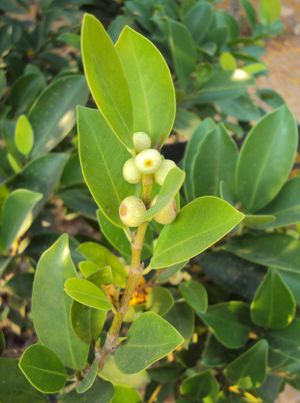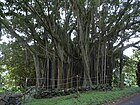Note: This is a project under development. The articles on this wiki are just being initiated and broadly incomplete. You can Help creating new pages.
Difference between revisions of "Ficus microcarpa - Laurel"
m (Prabhakar moved page Ficus microcarpa to Laurel Fig (Ficus microcarpa)) |
(→References) |
||
| (19 intermediate revisions by 2 users not shown) | |||
| Line 1: | Line 1: | ||
[[File:Ficus microcarpa.jpg|thumb|right|'' Kamarup'', ''Peeladamara'']] | [[File:Ficus microcarpa.jpg|thumb|right|'' Kamarup'', ''Peeladamara'']] | ||
| + | '''Ficus microcarpa''' is a banyan native in the range from Sri Lanka to India, southern People's Republic of China, the Malay Archipelago, the Ryukyu Islands, Australia, and New Caledonia. | ||
| + | ==Uses== | ||
| + | {{Uses|Wounds}}, {{Uses|Ulcers}}, {{Uses|Bruises}}, {{Uses|Flatulent colic}}, {{Uses|Hepatopathy}}, {{Uses|Dysentery}}, {{Uses|Diabetes}}, {{Uses|Hyperdipsia}}, {{Uses|Burning sensation}} | ||
| − | + | ==Parts Used== | |
| + | {{Parts Used|Leaves}}, {{Parts Used|Bark}}. | ||
| − | == | + | ==Chemical Composition== |
| + | Hydroxypentracosanoylamino]- heptadecane triol, ursa-dien-3alpha-ol, epifriedelanol, alpha-amyrin acetate, beta-sitosterol, beta-daucosterol, hexacosanoic acid, heneicosanoic acid<ref name="chemical composition"/> | ||
| − | + | ==Common names== | |
| + | {{Common names|kn=Peeladamara|ml=Itti, Kallithi|sa=|ta=Kallichchi|te=Plaksa|hi=Kamarup|en=Laurel Fig, Chinese Banyan}} | ||
| + | |||
| + | ==Properties== | ||
| + | Reference: Dravya - Substance, Rasa - Taste, Guna - Qualities, Veerya - Potency, Vipaka - Post-digesion effect, Karma - Pharmacological activity, Prabhava - Therepeutics. | ||
| + | ===Dravya=== | ||
| + | |||
| + | ===Rasa=== | ||
| + | Kashaya (Astringent) | ||
| + | ===Guna=== | ||
| + | Ruksha (Dry), Guru (heavy) | ||
| + | ===Veerya=== | ||
| + | Sheeta (Cold) | ||
| + | ===Vipaka=== | ||
| + | Katu (Pungent) | ||
| + | ===Karma=== | ||
| + | Kapha, Pitta | ||
| + | ===Prabhava=== | ||
| + | |||
| + | ==Habit== | ||
| + | {{Habit|Tree}} | ||
| + | |||
| + | ==Identification== | ||
| + | ===Leaf=== | ||
| + | {{Leaf|Simple|Alternate|Leathery, deep glossy green, oval-elliptic to diamond-shaped}}<ref name="Leaf"/> | ||
| + | |||
| + | ===Flower=== | ||
| + | {{Flower|Unisexual|2-4cm long|Yellow|5-20|Flowers Season is June - August}} | ||
| + | |||
| + | ===Fruit=== | ||
| + | {{Fruit|Tiny|1 cm in diameter|Specialized receptacle that develops into a multiple fruit|With hooked hairs|Many}} | ||
| + | |||
| + | ===Other features=== | ||
| + | |||
| + | ==List of Ayurvedic medicine in which the herb is used== | ||
| + | * [[Vishatinduka Taila]] as ''root juice extract'' | ||
| + | |||
| + | ==Where to get the saplings== | ||
| + | ==Mode of Propagation== | ||
| + | {{Propagation|Seeds}}, {{Propagation|Cuttings}}. | ||
| + | |||
| + | ==How to plant/cultivate== | ||
| + | Succeeds in full sun to partial shade. Prefers a moist, fertile soil<ref name="How to plant/cultivate"/> | ||
| − | == | + | ==Commonly seen growing in areas== |
| + | {{Commonly seen|Grows in widely varying locations}}, {{Commonly seen|Limestone hills}}, {{Commonly seen|Montane forest}}. | ||
| − | + | ==Photo Gallery== | |
| − | + | <gallery class="left" caption="" widths="140px" heights="140px"> | |
| − | + | Starr 040514-0204 Ficus microcarpa.jpg|Whole tree | |
| + | Starr 080601-5190 Ficus microcarpa.jpg|Leaves | ||
| + | Netrider-Ficus microcarpa 2.jpg|Young leaves | ||
| + | 2010 07 21220 6768 Da'an District, Taipei, Daan Park, Ficus microcarpa, Taiwan.JPG|At field | ||
| + | </gallery> | ||
| − | == References == | + | ==References== |
| − | + | ||
| − | <references> | + | <references> |
| − | <ref name=" | + | <ref name="chemical composition">[https://www.researchgate.net/publication/24348507_Studies_on_chemical_constituents_of_aerial_roots_of_Ficus_microcarpa Chemical constituents]</ref> |
| − | |||
| − | = | + | <ref name="Leaf">Kappatagudda - A Repertoire of Medicianal Plants of Gadag by Yashpal Kshirasagar and Sonal Vrishni, Page No. 192</ref> |
| − | + | <ref name="How to plant/cultivate">[http://tropical.theferns.info/viewtropical.php?id=Ficus+microcarpa Cultivation Details]</ref> | |
| − | + | </references> | |
| + | ==External Links== | ||
| + | * [https://www.bonsaiempire.com/tree-species/ficus Ficus microcarpa on bonsaiempire] | ||
| + | * [http://sphinxsai.com/2016/ph_vol9_no10/1/(201-206)V9N10PT.pdf Assimilation of Ficus microcarpa Hawaii plant growth and chemical constituents] | ||
| + | * [https://www.ncbi.nlm.nih.gov/pmc/articles/PMC4015825/ Chemical composition and Biological studies of Ficus benjamina] | ||
[[Category:Herbs]] | [[Category:Herbs]] | ||
| + | [[Category:Moraceae]] | ||
Latest revision as of 15:28, 10 May 2021
Ficus microcarpa is a banyan native in the range from Sri Lanka to India, southern People's Republic of China, the Malay Archipelago, the Ryukyu Islands, Australia, and New Caledonia.
Contents
- 1 Uses
- 2 Parts Used
- 3 Chemical Composition
- 4 Common names
- 5 Properties
- 6 Habit
- 7 Identification
- 8 List of Ayurvedic medicine in which the herb is used
- 9 Where to get the saplings
- 10 Mode of Propagation
- 11 How to plant/cultivate
- 12 Commonly seen growing in areas
- 13 Photo Gallery
- 14 References
- 15 External Links
Uses
Wounds, Ulcers, Bruises, Flatulent colic, Hepatopathy, Dysentery, Diabetes, Hyperdipsia, Burning sensation
Parts Used
Chemical Composition
Hydroxypentracosanoylamino]- heptadecane triol, ursa-dien-3alpha-ol, epifriedelanol, alpha-amyrin acetate, beta-sitosterol, beta-daucosterol, hexacosanoic acid, heneicosanoic acid[1]
Common names
| Language | Common name |
|---|---|
| Kannada | Peeladamara |
| Hindi | Kamarup |
| Malayalam | Itti, Kallithi |
| Tamil | Kallichchi |
| Telugu | Plaksa |
| Marathi | NA |
| Gujarathi | NA |
| Punjabi | NA |
| Kashmiri | NA |
| Sanskrit | |
| English | Laurel Fig, Chinese Banyan |
Properties
Reference: Dravya - Substance, Rasa - Taste, Guna - Qualities, Veerya - Potency, Vipaka - Post-digesion effect, Karma - Pharmacological activity, Prabhava - Therepeutics.
Dravya
Rasa
Kashaya (Astringent)
Guna
Ruksha (Dry), Guru (heavy)
Veerya
Sheeta (Cold)
Vipaka
Katu (Pungent)
Karma
Kapha, Pitta
Prabhava
Habit
Identification
Leaf
| Kind | Shape | Feature |
|---|---|---|
| Simple | Alternate | Leathery, deep glossy green, oval-elliptic to diamond-shaped |
Flower
| Type | Size | Color and composition | Stamen | More information |
|---|---|---|---|---|
| Unisexual | 2-4cm long | Yellow | 5-20 | Flowers Season is June - August |
Fruit
| Type | Size | Mass | Appearance | Seeds | More information |
|---|---|---|---|---|---|
| Tiny | 1 cm in diameter | Specialized receptacle that develops into a multiple fruit | With hooked hairs | Many | {{{6}}} |
Other features
List of Ayurvedic medicine in which the herb is used
- Vishatinduka Taila as root juice extract
Where to get the saplings
Mode of Propagation
How to plant/cultivate
Succeeds in full sun to partial shade. Prefers a moist, fertile soil[3]
Commonly seen growing in areas
Grows in widely varying locations, Limestone hills, Montane forest.
Photo Gallery
References
- ↑ Chemical constituents
- ↑ Kappatagudda - A Repertoire of Medicianal Plants of Gadag by Yashpal Kshirasagar and Sonal Vrishni, Page No. 192
- ↑ Cultivation Details
External Links
- Ayurvedic Herbs known to be helpful to treat Wounds
- Ayurvedic Herbs known to be helpful to treat Ulcers
- Ayurvedic Herbs known to be helpful to treat Bruises
- Ayurvedic Herbs known to be helpful to treat Flatulent colic
- Ayurvedic Herbs known to be helpful to treat Hepatopathy
- Ayurvedic Herbs known to be helpful to treat Dysentery
- Ayurvedic Herbs known to be helpful to treat Diabetes
- Ayurvedic Herbs known to be helpful to treat Hyperdipsia
- Ayurvedic Herbs known to be helpful to treat Burning sensation
- Herbs with Leaves used in medicine
- Herbs with Bark used in medicine
- Herbs with common name in Kannada
- Herbs with common name in Hindi
- Herbs with common name in Malayalam
- Herbs with common name in Tamil
- Herbs with common name in Telugu
- Herbs with common name in English
- Habit - Tree
- Index of Plants which can be propagated by Seeds
- Index of Plants which can be propagated by Cuttings
- Herbs that are commonly seen in the region of Grows in widely varying locations
- Herbs that are commonly seen in the region of Limestone hills
- Herbs that are commonly seen in the region of Montane forest
- Herbs
- Moraceae




